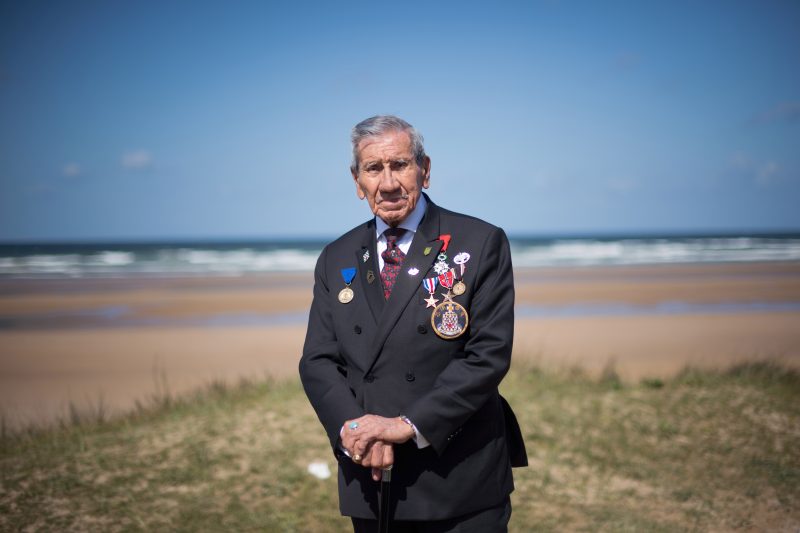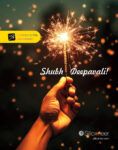Native Americans’ D-Day stories come to light
World War II veteran Charles Shay, a Penobscot Indian who took part in the D-Day landings at Normandy on June 6, 1944, on Omaha Beach in western France. (LOIC VENANCE)
Saint-Laurent-sur-Mer (France) (AFP) – Charles Norman Shay is one of the few remaining US veterans of World War II, but as a Native American the story of his people’s courage and sacrifice on the battlefield is little known.
Seventy-five years ago Shay was a 19-year-old military nurse on Omaha Beach, the bloodiest of the five Normandy sites picked for the D-Day landings.
Nearly 500 Native Americans fought alongside Allied soldiers to dislodge German forces from the French coast, marking the start of France’s liberation from its Nazi occupiers.
Some of them didn’t even have the right to vote in their home state, but decades later, their stories are finally coming to light.
After several years of discreet spiritual ceremonies with traditional garb, feathers and smoke, the first official Native American commemoration was held on Utah Beach in 2014.
It honoured 14 Comanche “code talkers” who worked in their indigenous language, unintelligible to Germans or Japanese.
On Wednesday 80 tribe members are expected to attend another Native American commemoration on Omaha Beach.
– ‘Every man for himself’ –
In 2017, Shay returned to the spot where he saved lives as a young nurse for the dedication of a granite sculpture of a turtle, a symbol of longevity and wisdom.
At nearly 95, Shay is thought to be the last surviving Native American who participated in the D-Day landings, when his infantry division, called the “Big Red One” after the number on its insignia, was one of the first to hit the water.
He watched as friends fell from their boat, shot down by German gunfire. Others jumped into the sea but were dragged under the water by their heavy equipment.
“It was every man for himself,” he told AFP, perched in a deckchair at the French home where he is being hosted in Bretteville-L’Orgueilleuse, a half-hour drive from Omaha Beach.
“I had to adjust my mind to seeing so many dead and wounded and helpless men, and once I was able to do this, I was able to function in the job I had been trained for, and that was to treat the wounded, to make them comfortable and to try to save the dying,” he said.
At home in Maine, members of the Native American Penobscot community called him “Little Muskrat,” an animal which, according to legend, saves people.
Thousands of miles away in Normandy, the nickname would turn out to be more fitting than ever.
“I landed in the water, up to my chest,” he recalled. “I had the beach under my feet. I made my way to the obstacles the Germans had placed in the water to hide behind… for protection against the fire.”
Once he made it onto the beach, Shay said he “selected a spot where I could heal the wounded”, before going back into the water to pull the injured to shore.
“The tide was coming in very fast. I noticed there were many men lying on the beach where the water was coming in. I thought, ‘If somebody doesn’t help these men, they are going to drown’,” he said.
“I put them on their backs, grabbed them under their arms, and tried to get them up to the high water line as best I could.”
– About a third volunteered –
An estimated 30,000 to 50,000 Native Americans fought in World War II, including 44,000 from the United States and 5,000 from Canada, according to Harald Prins, a Dutch anthropologist at Kansas State University who co-wrote a biography of Shay.
“A majority of North American Indians were drafted for the Second World War,” Prins said. “About a third, however, had voluntarily enlisted” despite opposition from some in their communities.
Signing up for the war appealed to some tribal members, while others seized a chance to earn money for their families.
These people “had only a few generations earlier defended their ancestral hunting territories against an aggressively expanding United States,” Prins said.
Native Americans have been recognised as US citizens since 1924, though the Constitution gave states the power to implement the policy as they wished.
It wasn’t until 1962 that all Native Americans got the right to vote.
Today, a memorial to Native American veterans is under construction in Washington, due to open in November 2020.
France has awarded its highest honour, the Legion d’Honneur, to several Native Americans involved in the war, including to Shay in 2007.
But for Shay, commemorating his people’s sacrifice will never replace the friends he lost on D-Day.
“Many of my friends died on these beaches,” he said. “I’m still here and I should be happy about that, I guess, but that’s a sorrow that so many men had to die here.”
Disclaimer: Validity of the above story is for 7 Days from original date of publishing. Source: AFP.


